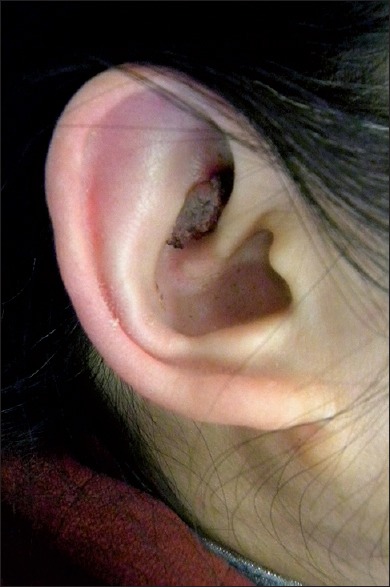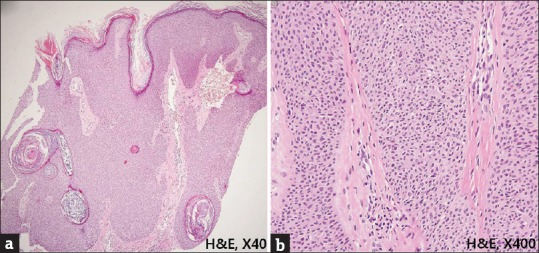Abstract
Eccrine poromas are benign, slow-growing, solitary tumors originating from the intraepidermal portion of eccrine sweat ducts. Approximately 65% of these tumors occur on the soles of the feet, while 10% occur on the hands where a high concentration of eccrine sweat glands exists. Less frequently it occurs in other sites such as neck, chest, forehead, nose, and scalp with sporadic occurrences. A 43-year-old Korean female presented with a mass on her right auricle, which had been present for 5 years. The mass increased gradually in size with pain, oozing, and bleeding. A biopsy of the mass revealed monomorphic basaloid cells, which may extend into the underlying dermis, in a richly vascularized stroma, with a variable number of cystic or ductal structures. The patient was diagnosed as having eccrine poroma. In this case, the eccrine poroma showed unusual clinical presentation.
Keywords: Auricle, ear, eccrine poroma
What was known?
The eccrine poroma could be found in the very unusual site, any skin surface area with sweat gland.
Introduction
Eccrine poromas are benign, slow-growing solitary tumors which are originated from the intraepidermal portion of the eccrine sweat duct.[1] This tumor had once been known to arise in bare skin of the palms and the soles, but recently it has become clear that this tumor can arise on any skin surface with sweat gland.[2] The patient visited our clinic with an eccrine poroma on the auricle, a site not previously reported. So we reviewed the literature of eccrine poroma cases and report an extremely rare case of an eccrine poroma developing on the auricle.
Case Report
A 43-year-old Korean female presented with a mass on the right auricle for 5 years. The mass gradually increased in size with pain, oozing and bleeding. On physical examination, the skin lesion revealed a solitary 2 × 1.5 cm dark to brownish colored verrucous surfaced mass on the right auricle [Figure 1]. There was no previous history of trauma. The clinical impression was verruca or verrucous carcinoma or basal cell carcinoma. A biopsy specimen of mass showed monomorphic basaloid cells, which extended into the underlying dermis, in a richly vascularized stroma, with a varying number of cystic or ductal structures [Figure 2a]. The nuclei were round, central and basophilic without atypical nuclear features or an infiltrative pattern to suggest malignant transformation [Figure 2b]. Therefore, the patient was diagnosed as having eccrine poroma. We recommended surgical excision, but the patient refused treatment.
Figure 1.

A solitary 1.5 × 2-cm dark brownish-colored verrucous surfaced mass on the patient's right auricle
Figure 2.

(a) The tumor consisted of broad anastomosing bands extending from the epidermis to the dermis (b) Higher magnification demonstrated typical poroid cells in an edematous vascular stroma without atypia (hematoxylin and eosin staining; A, ×40; B, ×400)
Discussion
The skin lesion of eccrine poroma usually presents as solitary, slowly-growing, skin-colored or pigmented, pedunculated, sessile papule or nodule.[3] Eccrine poromas typically arise in the middle-aged or elderly of both genders.[3] Pinkus et al.[4] first reported this entity in 1956. Approximately 65% of cases occur on the sole and 10% on the hands where high concentration of eccrine sweat glands exist. Other common sites are on the neck, chest, forehead, nose and scalp with sporadic occurrences.[3,5] To our knowledge, benign eccrine poroma occurring on auricle has never been reported in the literature.
Eccrine poroma is composed of poroid cells and cuticular cells. The cuticular cells have abundant eosinophilic cytoplasm, which resembles cuticles of eccrine ducts. Intracytoplasmic and intercellular vacuolization, resembling the formation of eccrine ducts, is also a characteristic histologic feature.
Eccrine poromas could be confused with basal cell carcinoma, seborrheic keratosis, squamous cell carcinoma, and rarely verruca or verrucous carcinoma as in our case. But in our case, histology finding showed consistency with eccrine poroma [Figure 2].
According to Moore et al.[6] who compared 10 cases of poroma of the head and neck with 10 cases of that of extremities, 3 cases (30%) of eccrine poroma on extremities exhibited clinical symptoms, such as pain, bleeding, clear discharge, or rapid growth. These symptoms may be related to trauma, particularly in lesion on the weight-bearing portion of the foot. However, unlike on extremities, eccrine poromas of the head and neck showed no symptoms. The eccrine poromas of the head and neck showed four times more pigmented tendency than extremity lesions. In our case, the mass was pigmented with pain, oozing and bleeding, symptoms which are presented more common in extremities than head and neck eccrine poromas. These symptoms may be induced by physical trauma due to secondary irritation by the patient.
In this case, eccrine poroma was found in the very unusual site, auricle with symptoms such as pain, bleeding and discharge. We suggest that this case contributes to the small part of literature on the potential for development of eccrine poroma on any skin surface area with sweat gland.
Footnotes
Source of support: Nil
Conflict of Interest: Nil.
References
- 1.Vu PP, Whitehead KJ, Sullivan TJ. Eccrine poroma of the eyelid. Clin Experiment Ophthalmol. 2001;29:253–5. doi: 10.1046/j.1442-9071.2001.00417.x. [DOI] [PubMed] [Google Scholar]
- 2.Harada T, Miyamoto T, Takahashi M, Tsutsumi Y. Eccrine poroma in the external auditory canal. Otolaryngol Head Neck Surg. 2003;128:439–40. doi: 10.1067/mhn.2003.37. [DOI] [PubMed] [Google Scholar]
- 3.Choi YJ, Kim HS, Lee JY, Kim HO, Park YM. Eccrine poroma on the postauricular area: A rare presentation. Ann Dermatol. 2013;25:92–4. doi: 10.5021/ad.2013.25.1.92. [DOI] [PMC free article] [PubMed] [Google Scholar]
- 4.Goldman P, Pinkus H, Rogin JR. Eccrine poroma; tumors exhibiting features of the epidermal sweat duct unit. AMA Arch Dermatol. 1956;74:511–21. [PubMed] [Google Scholar]
- 5.Johnson RC, Rosenmeier GJ, Keeling JH 3 rd. A painful step. Eccrine poroma. Arch Dermatol. 1992;128:1530–1533. doi: 10.1001/archderm.128.11.1530. [DOI] [PubMed] [Google Scholar]
- 6.Moore TO, Orman HL, Orman SK, Helm KF. Poromas of the head and neck. J Am Acad Dermatol. 2001;44:48–52. doi: 10.1067/mjd.2001.110048. [DOI] [PubMed] [Google Scholar]


